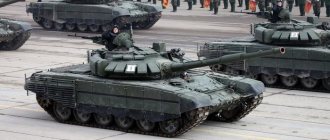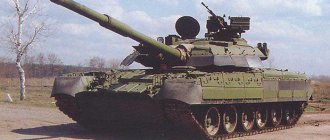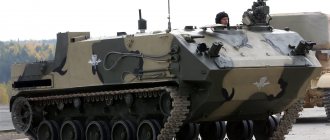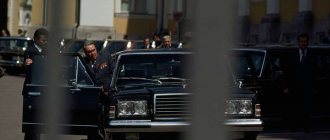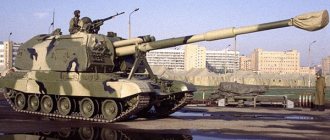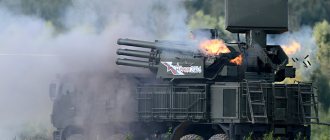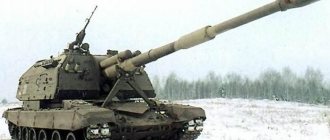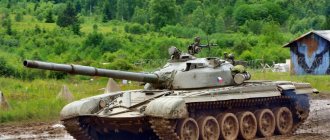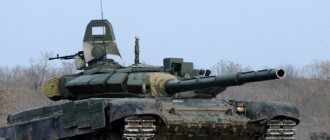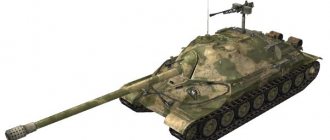History of creation
The history of the tank dates back to 1964, when at a meeting of the CPSU Central Committee it was decided to develop a new combat vehicle, using the T-64 as a basis. The innovative tank was conceived as a carrier of a gas turbine engine, which would contribute to a power reserve of 450 kilometers with 1000 horsepower and a warranty period of 500 hours.
The reason for making this decision is due to the obsolescence of the T-64. The management relied on gas turbine engines as a means of increasing the operational characteristics of a combat unit. A special feature of this mechanism was that there was no need to warm up before starting work, which significantly reduced the time it took to bring the tank crew into combat readiness. Especially in harsh winter conditions.
Tank T-80. Characteristics and modernization
In 1976, the Object-219 was put into service under the T-80 designation. This is how the first tanks with a gas turbine engine appeared. For comparison: the American Abrams tank was put into production only in 1980.
The T-80 tank (photo below) had a hull made of welded armor plates, largely similar in design to its predecessors - the T-72 and T-64A.
The turret is completely cast from armored steel, has a complex configuration and is equipped with a rangefinder. The caliber of the gun is 125 mm, the gun is equipped with a casing at the base of the barrel, the charging mechanism and the projectile loading system are in many ways similar to the T-64A. Also on the tower were the Utes anti-aircraft machine gun and the infantry PKT.
Type of armor: rolled and cast steel, as well as combined. The weight of the T-80 tank was 42 tons. Length (including the gun) - approximately 9656 mm, hull - 6780 mm, width - 3525 mm, height (from the lowest point to the top of the turret) - 3525 mm.
T-80 armament
The tank has a 125 mm smoothbore gun 2A46-1, later 2A46-2 / 2A46M-1, capable of firing guided missiles of the Cobra, Invar, and Reflex-M types. The direct fire range is 4000 meters, missiles fly up to 5000 meters. The ammunition load includes sub-caliber, high-explosive fragmentation and, of course, cumulative projectiles, with a separate cartridge charge. The total number varies depending on the modifications of the tank (38-45 charges).
The designers also transferred the loading mechanism from the T-64A.
The carousel of the T-80 mechanized combat stowage holds 28 rounds, the average rate of fire is 6-9 rounds. On production samples, the gun received a thermal casing. The tank is equipped with a coaxial Kalashnikov machine gun, caliber 7.62 mm. On the commander's turret there is a 12.7 mm Utes anti-aircraft weapon with a firing range of 1,500 meters against air targets and 2,000 meters against ground targets.
The table shows the performance characteristics of various T-80 tanks
| Type | T-80 | T-80B | T-80U | T-80UD |
| Design plant | Kirov Heavy Tank Manufacturing Plant | Kharkov Heavy Tank Manufacturing Plant | ||
| The tank entered service with the troops | 1976 | 1978 | 1986 | 1987 |
| Weight of equipment | 42 | 42,5 | 46 | 46 |
| Main Dimensions | ||||
| Length, (mm) | 6781 | 6983 | 7013 | 7021 |
| Width, (mm) | 3526 | 3583 | 3604 | 3756 |
| Height, (mm) | 2300 | 2220 | 2216 | 2216 |
| Ground clearance, (mm) | 450 | 527 | ||
| Availability and type of dynamic protection of the machine | ||||
| Dynamic armor | No | "Contact-1" | "Contact-5" | "Cactus" |
| Active protection | No | "Curtain" | ||
| Armor | Cast, welded, combined | |||
| T-80 armament | ||||
| Main weapon | 2A46 | 2A46-2 2A46M-1 | 2A46M-1 2A46M-4 | 2A46-1 |
| Firing range, m | 0-4000 | |||
| Tank ammunition | 40 | 38 | 45 | 45 |
| T-80 crew | 3 | |||
| Engine | ||||
| Type | Gas turbine (GTE) | Diesel | ||
| Power, hp | 1000 | 1110 | 1200 | 1000 |
| Maximum speed on asphalt | 70 | 60 | ||
| Speed on country roads | 40-50 | |||
| Engine power | 23,8 | 25,7 | 21,73 | 21,6 |
| Fuel capacity, l | 1845 | |||
| Fuel consumption l/km | 3,65 | |||
| Suspension | Torsion bar | |||
First tests
From approximately 1968 to 1974, experimental T-80 tanks (then still bearing modest experimental names like “Object-219”) underwent a series of tests. Some showed unsatisfactory results in the operation of the new type of engine, some completely failed.
After a number of modifications, the equipment was tested again - either in highly dusty conditions or during maneuvers on snow-covered virgin soil.
T-80 tanks with a diesel engine were noted for their high maneuverability when interacting with infantry fighting vehicles. The vehicle easily moved to the front positions in order to attack the enemy, developing a speed of 20 to 30 km/h.
On different types of terrain, these tanks showed average speeds from 20 to 40 km/h, while oil consumption tended to zero, and fuel consumption ranged from 435 to 840 liters.
Combat use of the most powerful tank of the Soviet Union
Oddly enough, the equipment created to protect the borders of the Soviet homeland did not take part in their defense. Not a single copy of the T-80 took part in battles for the USSR. The first combat use occurred on the territory of the Russian Federation in the fall of 1993.
It was the “eighties” who fired at the White House building in Moscow.
And then there was Chechnya. From 1995 to 1996, T-80 tanks took part in battles against the Republic of Ichkeria. I would like to note that the technology was used inadequately, sometimes not for its intended purpose.
Poor crew training, lack of dynamic protection, and the use of vehicles in urban and mountainous conditions led to losses. The command made conclusions and the T-80 was no longer used in the second Chechen campaign.
It should be said that after the collapse of the USSR, most of the tanks remained on the territory of Ukraine, along with the Kharkov plant, where this equipment was produced.
T-80BV and other upgrades
Technological progress did not stand still. In 1978, an improved version appeared - T-80B. It was distinguished by the presence of a “Cobra” controlled weapon system, a tactical system for launching smoke bombs “Tucha” and reinforced armor for both the hull and the turret.
At the same time, the T-80BK model was developed at the Omsk plant.
In 1985, the T-80BV model entered service. It differs from its predecessor in the presence of dynamic protection on the turret and hull.
The last and most successful modification was the T-80U model, developed in the same 1985. The design principles were inherited from previous 80 models. The weight increased to 46 tons.
The fire control system has received a number of improvements, such as a night and day gunner's aiming complex and a commander's computer-sighting mechanism.
Innovations made it possible to fight not only against armored targets, but also against low-flying helicopters thanks to the integrated Reflex missile guidance control system. The fired projectile is aimed at the pointer by a laser beam at a distance of 100 to 5000 meters.
Engine and transmission
The main difference between the T-80 and its predecessors and contemporaries is the gas turbine engine. The designers had to increase the length of the body due to its longitudinal location. The engine weight is 1050 kilograms, and the maximum speed is about 26 thousand revolutions per minute. In the engine compartment there are four fuel tanks with a total capacity of 1140 liters. The main advantage of a gas turbine engine is its versatility.
The engine runs successfully on a variety of aviation fuels (TS-1/2), as well as diesel fuel and low-octane gasoline. Thanks to the rear-facing turbine exhaust, the tank's noise signature was noticeably reduced, which had a positive effect on overall camouflage.
To facilitate the start-up of the gas turbine engine on the T-80, the designers installed an automatic engine operation control system (SAUR). This made it possible to increase its wear resistance by 10 times. The engine starts within -40° to +40° Celsius. Operational readiness is 3 minutes, engine oil consumption is minimal.
The transmission was heavily redesigned compared to the T-64.
The increased weight and power forced the designers to replace the drive and guide wheels, support and support rollers. The new tracks have rubberized tracks. Some experts consider telescopic shock absorbers to be the bane of a tank, but replacing them is not difficult even in the field. Thanks to these changes, the T-80 chassis is considered the best in its class.
Discontinuation of production
The T-80 tank (photo below) had a number of modifications intended for export to different countries of the world. There are countless of them. For example, the model “eighty” with a diesel engine, produced in Kharkov under the marking T-80UD, formed the basis of the military equipment of Ukraine: “Oplot”, BM “Oplot” and T-84.
Production of the "eighty" was discontinued in 1998. The reasons, unfortunately, are unknown. Nevertheless, the combat vehicle is still in service with the army of the Russian Federation.
Performance characteristics of new products
T-80 tanks were rightfully considered one of the most advanced achievements of domestic design thought. For comparison, their tactical and technical characteristics should be considered.
The T-80BV had a mass of 43.7 tons, while the T-80U was heavier and weighed as much as 46.
The length of the first, including the cannon, was 9651 mm, while the improved model was shorter - 9556 mm.
As for the body itself, it’s the other way around. The T-80B had a length of 6982 mm and a width of 3582 mm, while the T-80U had characteristics of 7012 mm and 3603 mm, respectively.
The difference in height is almost invisible to the naked eye. The numbers indicate the difference only in the documentation - 2219 versus 2215 mm.
